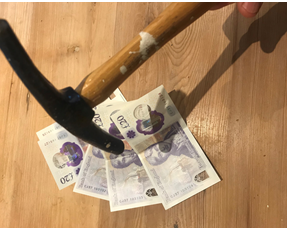22 October 2020
Noble Nobels?
Economics and the greater good.
By Frank O’Nomics
 Is making money from nothing worthy of a Nobel Prize? Last year’s Nobel Prize for Economics was won by two economists, Abhijit Banerjee and Esther Duflo, who had developed an experimental approach to alleviating global poverty. This is surely what Nobel prizes are all about – creating change for the good of mankind. This year the winners of the economics prize are less obvious in generating altruistic benefit. The work of Robert Wilson and Paul Milgrom on common value auctions, while having widespread application, might literally be argued as helping produce the economic equivalent of the pot noodle or bottled mineral water – something that is cheaply or feely available, repackaged to generate extreme profit. However, we should not denigrate their work as being merely focused on profit and efficiency – they too are involved in a noble pursuit, that might just get us out of a mess.
Is making money from nothing worthy of a Nobel Prize? Last year’s Nobel Prize for Economics was won by two economists, Abhijit Banerjee and Esther Duflo, who had developed an experimental approach to alleviating global poverty. This is surely what Nobel prizes are all about – creating change for the good of mankind. This year the winners of the economics prize are less obvious in generating altruistic benefit. The work of Robert Wilson and Paul Milgrom on common value auctions, while having widespread application, might literally be argued as helping produce the economic equivalent of the pot noodle or bottled mineral water – something that is cheaply or feely available, repackaged to generate extreme profit. However, we should not denigrate their work as being merely focused on profit and efficiency – they too are involved in a noble pursuit, that might just get us out of a mess.
One of the first things that we study in economics in the “invisible hand” of markets. Developed in the eighteenth century by Adam Smith, this theory argues that, provided that there is perfect competition and perfect information, markets will allocate resources efficiently and, ultimately, in the best interests of society. Problems develop when the preconditions are not met, and much of economic study since has been about how to address this.
One area of particular difficulty, where there has always been imperfect information, was that of auctions and the difficulty of the so-called “winner’s curse”. A key manifestation of this was in the process of bidding for US oil licenses. The highest bid for these licenses tended to come from those who were most optimistic regarding the values of the oil fields, when the real value was probably closer to the average bid. The result was often to leave oil producers with a less than economic prospect. Such constraints can be readily identified in other more everyday occurrences, such as the sealed bidding process for houses being sold in Scotland. The work of Wilson and Milgrom allowed a redesign of the process and the start of common value auctions, where all of the information regarding what was for sale is shared with potential bidders.
How did this create a money-for-nothing ‘pot noodle”? The most obvious examples come in the form of broadcast spectrum auctions. Previously the allocation process involved giving the rights either to working participants, or allocation was done via a lottery process, but in the US in 1994 an auction was constructed along lines proposed by Wilson and Milgrom. Instead of generating next to nothing, the auction realised $200bn, with bidders confident that they had sufficient information to evaluate true economic worth. That worth may have been different for each bidder, depending on their market position and existing infrastructure. The auction process created the maximum value for the sale and allocated the resource to those that could generate the best return. The potential use of the process is extensive and varied. It has been adopted for similar spectrum auctions in the UK and for fishing rights in New South Wales.
This brings us back to the key point. How can all of this be for the greater good? Clearly the winning bidders are not saddled with a loadstone that could lead to bankruptcy and redundancies, but the biggest benefit can come from the extra cash generated, that can be used to shore up government coffers. The 3G license auction in the UK in 2000 was initially expected to generate 5bn pounds, but in the event made 22.5bn, and that was 7 times greater than forecast to be generated from a conventional auction. This was a considerable proportion of the funding needed to cover that year’s budget deficit and, to put it into perspective, would have been sufficient to fund 400 new hospitals.
When we come to compare the benefit for mankind generated by the work of Nobel prize winners, it is very tempting to focus on those who, as last year, have done most to help the bottom billion. Hitherto, the work of Wilson and Milgrom may have largely been for the benefit of the developed world, but there is no reason why their methodology can’t be adopted by the governments of developing nations. Their work is a great example of economists generating theory and then becoming involved in the practical application. Not surprisingly, over the last 25 years they have been in great demand and, with an increasing need for all governments to find additional sources of revenue, the need for help has never been greater. Where might the next government “pot noodle” be found? Answers on a postcard to: Rishi Sunak, Her Majesty’s Treasury, Whitehall.

